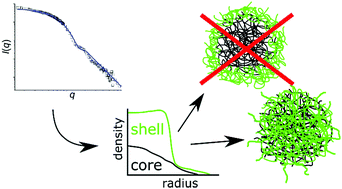Contrast variation SANS measurement of shell monomer density profiles of smart core–shell microgels†
Abstract
The radial density profile of deuterated poly(N,n-propyl acrylamide) shell monomers within core–shell microgels has been studied by small-angle neutron scattering in order to shed light on the origin of their linear thermally-induced swelling. The poly(N-isopropyl methacrylamide) core monomers have been contrast-matched by the H2O/D2O solvent mixture, and the intensity thus provides a direct measurement of the spatial distribution of the shell monomers. Straightforward modelling shows that their structure does not correspond to the expected picture of a well-defined external shell. A multi-shell model solved by a reverse Monte Carlo approach is then applied to extract the monomer density as a function of temperature and of the core crosslinking. It is found that most shell monomers fill the core at high temperatures approaching synthesis conditions of collapsed particles, forming only a dilute corona. As the core monomers tend to swell at lower temperatures, a skeleton of insoluble shell monomers hinders swelling, inducing the progressive linear thermoresponse.



 Please wait while we load your content...
Please wait while we load your content...